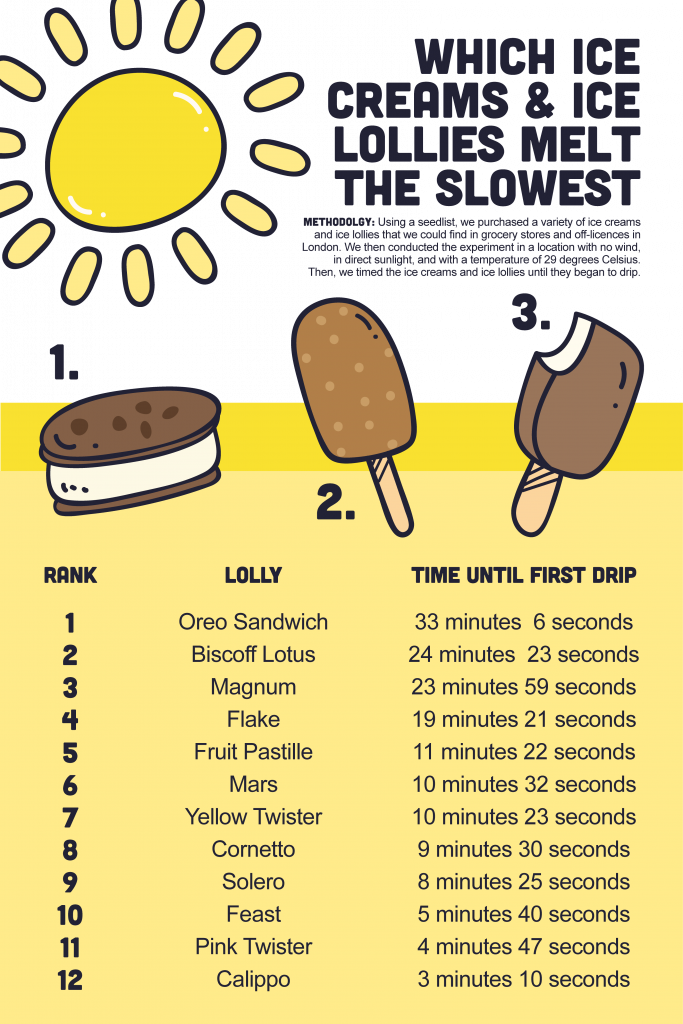Brace yourselves for yet another scorching summer! With the hottest recorded June to date and more warm weather on the way, Brits of all ages can look forward to a mouth-watering ice cream. Regrettably, the affair between ice cream and sun hasn’t always been a graceful one. From the moment the summer treat is pulled from its frozen paradise, the race to lap it up begins.
To help you cool off from the sun’s glare, we’ve reached out to the British public to discover the country’s favourite summer treat. We also went a bit further and performed an experiment to determine the frozen desserts that last the longest before melting. Sticky fingers and messy tops will be two less things to worry about this year as you tuck into your ice cream.
Calippo Named the Fastest-Melting Ice Cream
Keen to find out how long ice cream can hold itself in the sun, we decided to experiment on Britain’s national treasures. After buying a selection of 12 popular ice creams, we laid each one outside in direct sunlight on a 29°C day. We then set a timer to measure how long it took for the ice creams to start melting.
With a survival rate of only 3 minutes and 10 seconds, the Calippo was rumbled as the fastest ice cream to melt under the sun. As the seconds went by, we watched the ice lolly accept its fate as it swiftly softened within the packaging.
Another cherished ice lolly also performed poorly in the experiment. We watched the Pink Twister’s ice cream section slowly start to drip within 4 minutes and 47 seconds. Surprisingly, the ice section of the lolly took 9 minutes before beginning to melt. That doesn’t sound quite so bad if you have impeccable timing and a surefire scooping technique.
Although we experimented with four ice lollies, it was an ice cream stick that melted the fastest next. With a melt time of 5 minutes and 40 seconds, the Feast really didn’t stand a chance. By the time the Magnum and Lotus Biscoff saw their first drip, this chocolate delight had completely melted away.
Oreo Sandwich is the Slowest-Melting Ice Cream
For a care-free ice cream experience in the summer heat, the Oreo Sandwich is your safest bet. After an impressive 33 minutes and 6 seconds standing in the sun, the ice cream began to escape from the biscuits. When we snuck a taste (because we had to, of course) the ice cream itself was warm – so even though it held up the longest before melting, you’re still better off eating it quickly if you want to enjoy a nice cold treat.
The Lotus Biscoff ice cream also held up against the sun’s rays, lasting for 24 minutes and 23 seconds before starting to fall apart. The chocolate encasing did a great job of keeping its creamy interior from escaping, but there was only so much heat it could take. Once the first piece of chocolate broke off, it quickly turned into a melted mess.
The beloved Magnum didn’t fall too far behind, taking an impressive 23 minutes and 59 seconds to melt. Similarly to the Lotus Biscoff, the Magnum’s tough exterior worked hard to prevent its downfall, making it a reliable treat to enjoy during the hot summer months.
Magnum Crowned the UK’s Favourite Ice Cream
When it comes to summer treats, it comes as no surprise that the Magnum has been crowned the UK’s favourite, with 54% of Brits giving it their vote (that’s 36.3 million of us!). This is followed by the Cornetto claiming second place with 39% and the Flake coming in third with a quarter of us saying it’s our favourite.
However, despite being a core childhood memory, the humble ice pop –which also goes by the name of ice pole, tip-top or Mr Freeze –only got 3% of the votes. This drops to only 1% for those aged 55+ and 2% for 45 to 54-year-olds – they’re missing out, right?
Despite being the reigning champion for being the most heat-proof, the Oreo Sandwich is beloved by only 11% of Brits. However, now people know how well it can withstand the heat, it might become the go-to for a few more people!
It’s safe to say that all these ice creams reign as the nation’s favourites for very good reasons. Now you know how they handle the sun, will you opt for a safer ice cream experience or will you chance a dessert with a low melting point?
Methodology
Survey: Survey data is based on a survey conducted in July 2023 of 1,500 general UK consumers over the age of 18.
Experiment: Using a list of popular ice creams, we bought a variety of 12 from a grocery store and off-licence in London. The ice creams were left in direct sunlight with a temperature of 29°C and no wind. We timed the ice creams until they started to melt.





